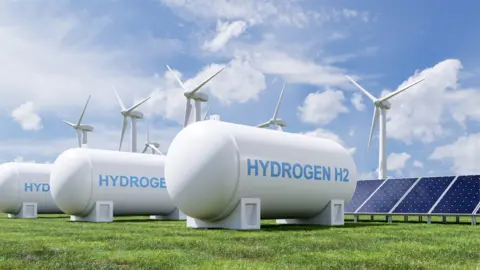Scotland's hydrogen opportunity

 Getty Images
Getty Images- An improved outlook for the economy has the unwelcome side effect of an increase in the cost of borrowing.
- Economic growth remains stagnant to sluggish, and one way of sparking more of it is investing in the Great Energy Transition. In that replacement of oil and gas, hydrogen is seen by some as the big game-changer.
- New studies of future demand for it in Scotland suggest it could provide nearly a fifth of total energy, mainly for use by heavy industry, trucks and shipping.
Things are looking up for the economy - so much that interest rates have gone up, again.
The Fraser of Allander Institute told us its quarterly survey of 400 Scottish firms, with Addleshaw Goddard, found growing order volumes and growing optimism, though disappointing numbers for business investment and exports.
And it may turn out significant that managers are putting up prices less because of energy costs than because of wage costs. If that looks like a "wage-price spiral" - rising prices fuel rising wages, which are passed on to rising prices - then the Bank of England will be back for a further clobbering of the economy.
Its 12th consecutive rise may not be the last in this unprecedented increase from 0.1% base rate at the Bank of England to 4.5%.
The central bank does not sound wholly confident that such measures are bearing down on inflation. It acknowledges that the response can take time, particularly as so much consumer lending is on fixed rate mortgages, so the tightening does not yet affect those people.
 Getty Images
Getty ImagesOther economic observers are not so confident that the Bank of England knows what it's doing, or that it's any good at doing it, or that raising interest rates at a time of stagnant growth and resilient high employment has the effect it would and should have in more normal circumstances.
Some want to see the government doing more on the fiscal side - spending or tax cuts - to spark growth into the economy. They forget, however, that was tried last autumn, with the infamous mini-budget which saw government policy undermining Bank of England policy, spooking the markets and seeing off Liz Truss's time in Downing Street.
Flying fuel
So governments are putting a bit more attention into the bit that could spark growth prospects over the horizon. That's where renewable energy comes in, and a hive of activity in Glasgow this week, at the All-Energy exhibition and conference. It has had "close to 600 speakers", which means a high ratio of speakers to listeners, but there's a lot to be said.
Humza Yousaf was one of the first to speak at it. Announcing £7m of funding to help spark activity in hydrogen energy isn't much, given the scale of the net zero challenge and the scale of investment that will be required.
But it's a signal of intent, and looking at the projects, the money is going towards innovation in extracting hydrogen from water in more remote places, including those where the electricity grid doesn't reach.
One of the bigger grants is a research park in Stornoway, with a view to an Outer Hebridean hydrogen network. That would and probably will be important to development of offshore wind in Atlantic waters.
Excess production and constrained export cabling are leading to outline plans to generate hydrogen for export from the islands. That could involve its conversion to ammonia, which is easier to store and transport, and which could spark an industry in production of fertiliser.
 Getty Images
Getty ImagesOther plans include projects to see if and how hydrogen can be stored in Scotland, and if there is potential at Glasgow Airport for a production hub. That could be linked to use of hydrogen as a future aviation fuel.
The new first minister also used his first major energy speech to put pressure on the UK government - as industry is doing - to get into the race for new green technologies, being run at blistering pace by industrial subsidy in the United States, and increasingly by the European Union and Canada.
Without that, big investments in new technologies and in manufacturing, are likely to go elsewhere, where the subsidies are.
A clearer picture of the way hydrogen could affect Scotland and the Scottish economy emerged from studies carried out for Scottish Enterprise and published by that government agency this week.
This looked at likely demand patterns for hydrogen, and concluded that hydrogen, by 2045 - only 22 years of massive change away - could provide 18% of Scotland's total energy needs in 2019 (those needs could have gone up or down).
A lot of the demand is likely to come from refining and chemicals based in and around Grangemouth. The oil and gas industry is seen as another major customer for the greener energy source, though it also sees hydrogen production from natural gas as one way that it can keep drilling.
Pharmaceuticals could also be a significant user of hydrogen power, putting Ayrshire onto the map for a potential hub.
The construction industry could be a user of hydrogen, as it is hard to decarbonise by other means. But of course, building sites are only temporary. The key could be "decentralised generators", able to fuel construction sites and major events, from sports to music festivals.
Aggreko, based in Glasgow and assembling its generators in Dumbarton for use around the world (most notably in powering Olympic Games and big football tournaments), could be a big part of that.
A more detailed study was carried out into whisky distilling, which could have various ways of accessing hydrogen to replace gas fired boilers for its brewing and distilling processes.
 Getty Images
Getty ImagesThis is tricky, as the nature of the industry is dispersed and often in rural areas. The infrastructure to get hydrogen to such industrial sites is just one of the constraints. So would distilleries have to deploy their own hydrogen hubs, using nearby wind turbines?
Transport could use it as well, but the expectation that it could be of use in cars is waning. Batteries are seen as making more sense in terms of anticipated cost, as they do even for urban buses.
Passenger trains have spearheaded the prototype deployment of hydrogen, but don't look like becoming a big customer, where the infrastructure of electricity can power them instead.
Instead, it looks more like heavy transport being a heavy user of hydrogen, including trucks and shipping, plus some agriculture that reaches beyond the electricity grid, or where the need for refuelling is a constraint.
The other area where hydrogen was seen as the answer to a huge decarbonising challenge was in home heating. That is looking less likely. Even non-domestic heating is seen in these Scottish Enterprise reports as having a relatively low potential, including the use of hydrogen to fire up Scotland's crematoria.
Hydrogen as an energy source has its doubters and critics, and it remains a heated debate. The green variety, derived from water using renewable energy, is welcomed. But the blue variety, from cracking natural gas, much less so.
It would require a lot of carbon capture and storage, putting a lot more emphasis on the 'net' - the mitigation of burning fossil fuels - than on the 'zero'.
